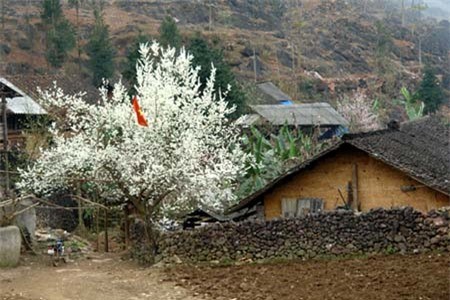(VOVworld) – The Mong people live mainly in Ha Giang, Lai Chau, Son La, and Yen Bai province. Each Mong group has its own construction techniques but the Mong traditionally use wood and earth. Lan Anh has a report on the houses of the Flowery Mong.

"Trinh tuong", earthen houses of the Mong people
|
The houses of the Flowery Mong in Lai Chau and Son La province are made of wood with earthen floors and fiber cement roofing panels. Mua A Xanh of Son La province told us: “In the past, our ancestors made simple wood houses with thatched roofs. Now the government helps us buy fiber cement roofing panels. It’s durable and more stable. A thatched roof can easily rot or catch fire. Previously, whenever we left our children at home to go to work in the terraced fields, we worried they would mischievously cause a fire. Now we are confident about going to work.”
The house has a simple design consisting of 3 rooms. The main room is for the ancestral altar, family activities, having meals and entertaining guests. Two other rooms are separated for personal purposes by curtains. In the house, the cooking space is very important. Xanh again: “The Giang clan places the cook-stove in the left or right room, while the Mua clan only places the cook-stove in the right-hand room. Our ancestors located the cook-stove for smooth production. We have a big cook-stove just for breakfast and a smaller one for other meals.”
 |
The Mong install a square or round pillar in the center of the house from the floor to the ceiling. When the family has an important event such as a wedding, funeral, or ceremony to pray for good crops, they burn incense on the ancestral altar and at the foot of the pillar to inform their ancestors and the land genie. During the New Year holiday, the pillar is decorated with colored paper. There is a taboo against chopping, leaning against, or dirtying the pillar, or burning things near the pillar. Mua Van Su of Lai Chau province says his house has been unchanged since it was built in 1995. “My grandparents and parents left me this house. There are two main pillars inside and outside the house. The outside pillar represents the family’s head.”
The main pillars are important in the spiritual life of the Flowery Mong people and remind people of their family history and unity among family members. Mua A Xanh again: “The Mong people have a time-honored tradition of mutual assistance. When one family in the hamlet builds a house, their neighbors will come to help without being asked. When people in other hamlets ask for help, we’ll go immediately.”
The Flowery Mong often build houses in the spring, after the New Year holiday. They begin the construction on even dates, which they believe are lucky good days.